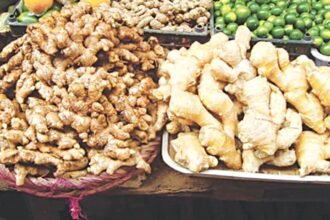
By ALLAH BAKHSH GULSHAN
GHAZI UNIVERSITY DERA GHAZI KHAN
Agriculture economy of Pakistan depends on the Kharif and Rabi crops. But kharif crops have a major share in the GDP of the country. August is the best month to grow the kharif crops or vegetables like Rice, Maize, Cotton, Soybean, Groundnut and vegetables like okra, eggplant, and chili peppers etc. cultivation of kharif crops and their management during the monsoon season is crucial for ensuring food security and farmer livelihoods. However, pest management in Kharif crops during the monsoon season is a significant challenge due to the complex interplay of climate, soil, and water factors. The current overview relates to discuss the role of soil, water and climate, in Kharif crop and the pest management during the monsoon season and suggests possible solutions and future recommendations. All that is the part of this preliminary but necessary account.
1.Impact of Climate on Pest Management
Climatic fluctuations play a perilous role in pest management in Kharif crops during the monsoon season e.g. rise and fall in temperature, increase and decrease in humidity in the air and soil, and rainfall can all impact pest populations and their behavior. Firstly, changes in temperature of the surroundings affects the development and reproduction of pests. for example, the hottest temperatures can lead to an increase in pest populations, while the coldest temperatures can slow down their development and growth. Secondly, variation in humidity in the edaphic as well as the climatic factors affects significantly on the pest proliferation. e g. Increase in humidity can favor the growth and development of pests, while decrease in humidity can reduce their populations. Thirdly, the excessive rainfall can lead to an increase in pest populations, while drought conditions can reduce their numbers.
- Role of Soil in Pest Management
The soil texture plays a vital role in the pest management and soil health is critical for pest management in Kharif crops during the monsoon season. Soil can harbor pests and diseases, and poor soil health can make crops more susceptible to pest attacks. Different soil types can affect pest populations and their behavior. For example, clay soils can retain moisture, creating an ideal environment for pests. in addition, poor soil health can lead to an increase in pest populations, while healthy soils can support beneficial organisms that help control pests.
- Impact of Water on Pest Management
Water management is essential for pest management in Kharif crops during the monsoon season. Excessive water can lead to an increase in pest populations, while water stress can reduce crop yields. The proper irrigation management can help to reduce pest populations by avoiding excessive water application. But poor drainage can lead to waterlogging, creating an ideal environment for pests and vice versa for crops
- Possible Solutions for Pest Management
To manage pests effectively in Kharif crops during the monsoon season, the following solutions can be implemented that includes: 1. IPM (Integrated Pest Management): IPM involves using a blended technique, including chemical, biological and socio-cultural controls, to manage pests. 2.Crop monitoring: Monitoring of crops regularly can support to notice pest influxes early, allowing for timely intrusion.3. Biological control: Biological control agents, such as natural enemies and beneficial insects, can help to control pest populations.4. Resistant varieties: Planting resistant crop varieties, which can help to reduce the pest populations and minimize damage.
- Future Recommendations
To improve pest management in Kharif crops during the monsoon season, the following future recommendations can be considered: 1 Climate-smart agriculture: To develop climate-resilient crop varieties and applying the climate-smart agricultural practices can help growers’ adaptation for changing climatic conditions. 2. Soil health management: By Improving soil health through sustainable agricultural practices can help reduce pest populations and promote beneficial organisms. 3. Water management: By implementing efficient water management practices can help reduce pest populations and minimize crop damage. 4. Research and development: Continuation of research and development activities in the public sector organizations and Institutions are playing vital role to improve the understanding of pest dynamics and to develop effective management strategies.
Finally, it is concluded that although the best pest management methods for Kharif crop during the monsoon season is a complex challenge that requires a comprehensive approach. By understanding the role of climate, soil, and water in pest management, farmers and policymakers can develop effective strategies to manage pests and ensure food security and farmer livelihoods. Implementing integrated pest management practices, improving soil health, and managing water efficiently can help to reduce pest populations and minimize crop mutilation.
Recommendations for Farmers
There are following important recommendations for the Pakistani peasants
- Monitor crops regularly: Monitor the crops regularly and vigilantly that could help to detect pest infestations in early stages, then this timely observation to allow for intervention.
- Use IPM practices: Implementing the effective IPM practices that could help to manage the pests effectively and meanwhile the use of chemicals will be reduced.
- Improve soil health: Through sustainable agricultural practices to improve the soil quality which can help in reduction of pest populations and promote beneficial organisms.
- Manage water efficiently: By implementing the water management practices in efficient way to help in reduction of pest populations and to minimize the damage of crops development and growth.
Recommendations for Policymakers
The policymakers of the agriculture to follow the proposed recommendations for the betterment of agriculture in Pakistan and they could play a better role in boosting the GDP of Pakistan in the sector of agriculture and their allied sciences. The recommendations include:
- Develop climate-resilient crop varieties: Developing climate-resilient crop varieties can help to the farmers to adapt and grow the crop varieties which can tolerate the climatic changes in the best way.
- Promote sustainable agriculture: Promoting sustainable agricultural practices can help to improve soil health and reduce pest populations.
- Support IPM practices: Supporting IPM practices can help farmers to manage pests effectively and reduce chemical use.
- Invest in research and development: The continued investment in research and development sectors of the stakeholders and the policy makers is necessary to improve our understanding of pest dynamics and develop effective management strategies. PAKISTAN ZINDA BAD





